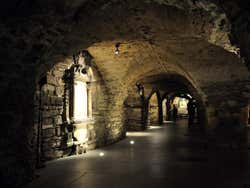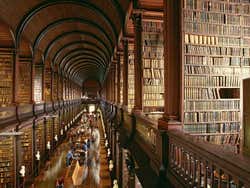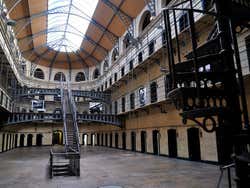
History of Dublin
Discover Dublin’s compelling past from when it was a small Viking settlement called Dyflin and how it became the capital of the Republic of Ireland.
The exact date of Dublin’s foundation is unknown, but it's thought that the bay where Dublin currently sits was inhabited thousands of years ago by hunter-gatherers. During the second century B.C., the settlers in the area erected large monuments made of stone, still visible to this day.
Viking settlement
The first reference found to Ireland’s capital, at that time called Eblana, can be found in Ptolemy’s document (Geographia). This Greco-Roman astronomer, astrologer and mathematician refers to the ancient settlement in approximately AD 140.
It is believed that the Celts landed in the bay around 700 BC. The Celts were converted to Christianity during the fifth century by St. Patrick, Ireland’s patron saint. Christianity has strongly marked Ireland's history, even up to the present day.
In the 9th century, around 841, the Vikings arrived in the region and established a settlement on the southern bank of the River Liffey, known as Dubh Linn (Black Pool). Meanwhile, the Celts lived on the northern shore of the river, in an encampment called Áth Cliath (the Town of the Ford of Hurdles).
In 1988, Dublin celebrated a millennium, making its foundation date official.
In 1014, the Irish High King Brian Boru defeated the Vikings.
During the 12th century, the city was ultimately conquered by the Normans.
Anglo-Norman Invasion of Ireland
At the end of the 12th century, the King of Leinster in Ireland, Diarmait Mac Murchada (Dermot MacMurrough) asked King Henry II of England for help to reconquer his kingdom, which had been taken from him by the High King of Ireland.
Henry II sent his troops to Ireland in 1169 and by the following year, the island was under the rule of the King of England.
During this period, Dublin was made the military and judicial centre of Ireland and grew exponentially with the arrival of the English, Dutch and Jews.
Around 1350, the Irish nobility rebelled against the Norman domination.
Two centuries later, Henry VIII, who had initiated the English Reformation, tried to impose the Church of England on all of the territories under the King of England. However, the Catholic Irish refused. Consequently, Henry VIII crushed the Irish rebellion and initiated major reforms to transform it into a Protestant country. He dissolved all the monasteries and shortly after, Ireland lost its autonomy.
The Kingdom of Ireland 1542 – 1800
Henry VIII of England was proclaimed King of Ireland in 1542, although he wasn’t acknowledged by the Catholic monarchies in Europe. During his reign, one of his main concerns was to convert the population to Protestantism. In 1592, Trinity College, Ireland’s first university, was established in Dublin on the land that had been confiscated from a monastery. Only Protestant students could attend.
The Irish population continued to resist Protestantism until they were defeated during the Siege of Kinsale in 1601 and England finally conquered all Gaelic Ireland. After the siege, an Act of Supremacy was issued, whereby the high posts were only given to Protestants or Englishmen.
The Irish undertook a coup d’état in October 1641 and tried to regain control of Ireland from the English. This led to the creation of the Catholic Confederation, a form of government unaligned with the English administration, that lasted nearly ten years until Oliver Cromwell overthrew the Catholics in the 1650s.
From 1688 until 1690, Dublin supported the last Catholic monarch of England, James II, against William I, Prince of Orange, who was Protestant, during the Jacobite War in Ireland. In 1690, James II was defeated and this gave rise to over two centuries of British and Protestant ruling in Ireland.
During the 18th century, the city of Dublin grew rapidly, partly because of the Huguenots, the French Protestants chased out of France, who had immigrated to Ireland’s capital. Trade bloomed and Dublin became the fifth largest city in Europe.
Ireland under British reign 1801-1922
In 1801, England crushed various revolts and abolished the Irish Parliament. However, the Catholics managed to regain some basic rights.
The Acts of Union 1800 integrated the United Kingdom and Ireland, creating the United Kingdom of Great Britain and Ireland.
Between 1845 and 1849, a plague destroyed the potato harvests, which led to the terrible potato famine, also known as "The Great Hunger", killing over one million people. The potato had been the main source of nutrients for families in Ireland due to the export of other produce to England.
During the famine, over 2 million Irish people left Ireland and immigrated to numerous countries. In just a few decades, Ireland’s population was reduced by a quarter.
Around 1900, Dublin was no longer the country’s most important city, surpassed by Belfast, as a result of its Industrial Revolution.
In 1905, Arthur Griffith founded Sinn Féin, the Irish political party meaning in English “We Ourselves”. It was the leading party for Irish nationalism.
In 1916, Irish Republicans organised a Rebellion called the Easter Rising against British rule. The English suppressed the insurgency and arrested over 3,000 men and women, most of which were shortly released, however, the leaders were executed. The Irish, consequently, became more and more infuriated against the British and Irish nationalism grew throughout the country.
In 1919, the Irish Republican Army (IRA), made up of Irish volunteers, rebelled against the British forces, and for 3 consecutive years, part of Dublin was severely damaged because of the conflict. In 1921, the Irish and British signed the Anglo-Irish Treaty, giving Ireland the ability to create a self-governing state. The Anglo-Irish Treaty led to internal conflicts, some in accordance with the treaty and others believing it wasn't enough. In 1922, the Irish Civil War broke out, lasting a year.
The Irish Free State 1922-1937
The IRA and Sinn Féin rejected the Irish Free State, which was constituted as a Dominion of the British Commonwealth of Nations, as they considered it insufficient. Another issue was that Northern Ireland opted out of the Free State, which created even more internal conflicts.
In 1937, a new constitution was prepared by Éamon de Valera and approved by a referendum. The new state was called Ireland or Eire in Irish.
After World War II, the Republic of Ireland was proclaimed after the Republic Act on April 18th 1948.
Dublin, The Capital of Ireland
In 1973, Ireland became a member state of the European Union. Since then, it has expanded rapidly. Many multinationals installed their headquarters in Dublin and the city has since become very cosmopolitan.
Currently, Dublin is a very popular tourist destination, especially among Europeans who enjoy the city’s young and relaxed atmosphere.


